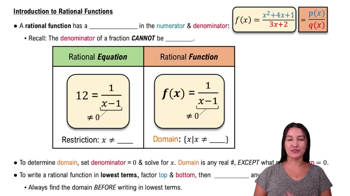Table of contents
- 0. Functions7h 52m
- Introduction to Functions16m
- Piecewise Functions10m
- Properties of Functions9m
- Common Functions1h 8m
- Transformations5m
- Combining Functions27m
- Exponent rules32m
- Exponential Functions28m
- Logarithmic Functions24m
- Properties of Logarithms34m
- Exponential & Logarithmic Equations35m
- Introduction to Trigonometric Functions38m
- Graphs of Trigonometric Functions44m
- Trigonometric Identities47m
- Inverse Trigonometric Functions48m
- 1. Limits and Continuity2h 2m
- 2. Intro to Derivatives1h 33m
- 3. Techniques of Differentiation3h 18m
- 4. Applications of Derivatives2h 38m
- 5. Graphical Applications of Derivatives6h 2m
- 6. Derivatives of Inverse, Exponential, & Logarithmic Functions2h 37m
- 7. Antiderivatives & Indefinite Integrals1h 26m
- 8. Definite Integrals4h 44m
- 9. Graphical Applications of Integrals2h 27m
- 10. Physics Applications of Integrals 2h 22m
1. Limits and Continuity
Finding Limits Algebraically
Problem 2.28b
Textbook Question
Finding Limits
In Exercises 25–28, find the limit of g(x) as x approaches the indicated value.
5 ―x²
lim ------------- = 0
x → ―2 (√g(x))
 Verified step by step guidance
Verified step by step guidance1
Identify the function g(x) given in the problem. Here, g(x) is not explicitly defined, but we are given an expression involving g(x) in the limit.
Rewrite the limit expression in a more standard form. The problem states: lim (5 - x²) / (√g(x)) as x approaches -2. This suggests that g(x) is related to the expression in the denominator.
Assume that g(x) is such that the expression (5 - x²) / (√g(x)) is defined and continuous around x = -2. This might involve simplifying or rationalizing the expression.
Evaluate the limit by substituting x = -2 into the expression, if possible. If direct substitution leads to an indeterminate form, consider using algebraic manipulation or L'Hôpital's Rule to resolve the indeterminate form.
Conclude by stating the limit value, ensuring that the steps taken are consistent with the properties of limits and continuity.
 Verified video answer for a similar problem:
Verified video answer for a similar problem:This video solution was recommended by our tutors as helpful for the problem above
Video duration:
2mPlay a video:
Was this helpful?
Key Concepts
Here are the essential concepts you must grasp in order to answer the question correctly.
Limits
A limit is a fundamental concept in calculus that describes the behavior of a function as its input approaches a certain value. It helps in understanding how functions behave near specific points, even if they are not defined at those points. For example, the limit of a function can indicate whether it approaches a finite value, infinity, or does not exist as the input approaches a particular value.
Recommended video:

One-Sided Limits
Continuous Functions
A function is continuous at a point if the limit of the function as it approaches that point equals the function's value at that point. This concept is crucial when evaluating limits, as discontinuities can lead to different limit behaviors. Understanding continuity helps in determining whether the limit can be directly substituted or requires further analysis.
Recommended video:

Intro to Continuity
Rational Functions
Rational functions are ratios of polynomials, and their limits can often be evaluated by simplifying the expression. When finding limits involving rational functions, it is important to identify any points of discontinuity, such as holes or vertical asymptotes, which can affect the limit's value. Techniques like factoring and canceling common terms are often employed to simplify the limit calculation.
Recommended video:

Intro to Rational Functions

 5:21m
5:21mWatch next
Master Finding Limits by Direct Substitution with a bite sized video explanation from Callie
Start learningRelated Videos
Related Practice







